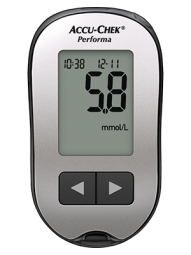- Home
- Meter Systems
- Performa
- Support
User Manuals
how-to videos
Frequently Asked Questions
Yes. Simply go into setup mode and turn the beeper off.
In the same way that fresh blood should always be used for testing, fresh control solution should be used to prevent a contaminated control drop. Control solution should always be wiped from the tip of the bottle so that only what is in the bottle itself is used for the test.
The meter is compatible with all Accu-Chek data management tools, including the Accu-Chek 360o diabetes management system.
Control test values will not be in the user-accessible memory. However, they will be stored in the downloadable memory.
With the new Accu-Chek Performa blood glucose meters, it is not necessary to delete stored results. Once 500 blood sugar (glucose) results are in the memory, adding a new result causes the oldest one to be deleted.
Watch this short video to see how easy it is to set the date and time.
(insert appropriate link)
Your meter comes with the batteries already installed and a preset time and date. You may need to change the time to match your time zone or, if you live in a state that observes daylight saving time, to reflect the time change.
To change these settings:
- Press and release the On/Off button to turn the meter on. The flashing test strip symbol appears. NOTE: If this is the first time your meter has been turned on, it will automatically enter the set-up mode, and "Set-up" and the hour will flash on the display. Skip to Step 3 to change the time or, if the date and time are correct, press and hold the On/Off button to exit the set-up mode.
- To enter the set-up mode, press and hold the On/Off button for about four seconds. “Set-up” and the hour flash on the display.
- Press and release the arrows to decrease or increase the hour. Press and hold the arrows to scroll faster.
- Press and release the On/Off button to set the hour. The minutes flash.
- Repeat steps 3 and 4 to set the minutes, AM/PM, month, day and year. The flashing field is the one you are changing.
- Once you set the correct time and date, press and hold the On/Off button until the flashing test strip symbol appears.
No, the meter will no longer provide an automatic warning message telling you that your vial of test strips will soon expire or lock you out once they have expired.
Your battery should last for approximately 2,000 tests.
Make sure you have a new 3-volt, lithium battery, number CR2032, to insert. Open the battery door on the back of the meter, remove the old battery for at least 20 seconds, and press any button on the meter. Insert the new battery with the “+” sign facing out. Snap the battery door back into place. Press the on/off button, and the meter will beep. Setup and hour are flashing on the display. If the date and time are correct, press and hold the on/off button for about 4 seconds. Release the button, and you’re done.
The meter uses 1 3-volt lithium coin cell battery (type CR 2032) found in many stores.
General questions
Roche goes above and beyond to deliver safe, accurate and dependable products.
For every lot of Accu-Chek test strips, containing millions of strips, one out of every 100 vials is tested for consistency of performance
Vials representative of the entire lot are tested a second time, some in a lab setting and others with blood from actual people with diabetes to reflect a real-world environment As a result of our quality assurance process, we won’t release affected test strips when any of the samples show a reading outside our accepted limits. Find out more on our Meter Accuracy page. (insert appropriate link)
Because your monitor and lab tests don't measure the same thing, these numbers are likely to vary. Lab tests generally test plasma, but a meter uses whole blood. As a result, even if you take both tests at the exact same time, your meter is likely to show a lower number than the lab results. This is perfectly acceptable, and your healthcare professional will already be factoring this in.

